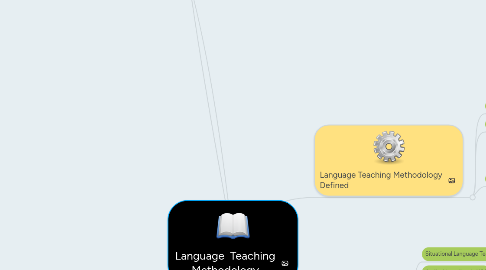
1. Background
1.1. Concept of "methods" of language teaching
1.2. Teaching practices
1.3. Systematic set
1.4. Theory of language
1.5. Language learning
1.6. Better methods
2. Yesteryear's method labels
2.1. 1. Teacher/Learner Collaborates
2.1.1. Link learners and teachers with similar styles
2.2. 2. Method Synergistics
2.2.1. Disciplined Eclecticism
2.3. 3. Curriculum Developmentalism
2.3.1. Methodology is one of several instructional considerations.
2.4. 4. Content-Basics
2.4.1. Language educators is literature and language itself
2.5. 5. Multintelligencia
2.5.1. Adaptaded language classroom
2.5.1.1. Linguistic
2.5.1.2. Logical
2.5.1.3. Spatial
2.5.1.4. Bodily
2.5.1.5. Musical
2.5.1.6. Interpersonal
2.5.1.7. Intrapersonal
2.5.1.8. Naturalist
2.6. 6. Total Functional Response
2.6.1. Discourse and genre analysis
2.6.2. Schema theory
2.6.3. Pragmatics
2.6.4. Systemic/functional grammar
2.6.5. Report
2.6.6. Procedure
2.6.7. Explanation
2.6.8. Exposition, and Recount
2.7. 7. Strategopedia
2.7.1. "Learning to Learn"
2.7.2. memory tricks
2.7.3. cognitive and metacognitive strategies
2.7.4. learning,
2.7.5. thinking,
2.7.6. planning
2.7.7. self-monitoring
2.8. 8. Lexical Phraseology
2.8.1. A minority of spoken clauses are entirely novel creations
2.8.2. memorized clauses
2.8.3. clause-sequences
2.9. 9. O-zone Whole Language
2.9.1. Focus on Form
2.9.2. consciousness-raising
2.9.3. noticing
2.9.4. attending
2.9.5. enhancing input
2.9.6. engagement with language
2.9.7. literary study
2.9.8. process writing
2.9.9. authentic content
2.9.10. learner collaboration
2.10. 10. Full-Frontal Communicativity
2.10.1. small fraction of total meaning
2.10.2. Communicate information non-verbally
2.10.3. including rhythm
2.10.4. speed
2.10.5. pitch
2.10.6. intonation
2.10.7. tone
2.10.8. hesitation phenomena in speech and gesture
2.10.9. facial expression
2.10.10. posture
2.10.11. distance in non-verbal messaging.
3. Language Teaching Methodology Defined
3.1. Links theory and practice
3.2. Theories of second language acquisition (SLA)
3.3. Design features of language instruction
3.3.1. Stated objectives
3.3.2. Syllabus specifications
3.3.3. Types of activities
3.3.4. Roles of teachers
3.3.5. Learners and materials
4. Schools of Language Teaching Methodology
4.1. Situational Language Teaching in UK
4.2. Audio-Lingualism in USA
4.3. Community Language Learning
4.4. Silent Way
4.5. Suggestopedia
4.6. Total Physical Response
4.6.1. Communicative Language Teaching (CLT).
4.6.1.1. communicate
4.6.1.2. Fluency
4.6.1.3. Authentic
4.6.1.4. Learning
4.6.1.5. Language Skills
4.6.1.6. The Natural Approach
4.6.1.7. Cooperative Language Learning
4.6.1.8. Content-Based Teaching
4.6.1.9. Task-Based Teaching.

